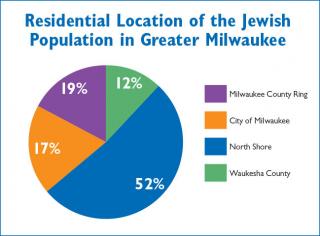The Milwaukee Jewish Federation has issued a revised report for the “Jewish Community Study of Greater Milwaukee 2011.”
The new report draws a somewhat different picture of Milwaukee-area Jewry; and this different picture looks much more like similarly-sized American Jewish communities.
Perhaps the most significant change reported is the total number of Jews in the Milwaukee area, which is now estimated at 25,800 and not 30,000 as originally stated.
The distribution of Jews residing in the Milwaukee area is also somewhat different. Larger percentages of Jews live on the North Shore and in the City of Milwaukee than originally reported, whereas the percentages of Jews living in Waukesha and the Milwaukee County ring are smaller.
How is all this known? Because the Berman Jewish DataBank of the Jewish Federations of North America had discovered there was something wrong with how the data were analyzed in the original study.
Laurence Kotler-Berkowitz, Ph.D., director of the DataBank, explained to The Chronicle what happened, in a telephone interview on April 20.
The DataBank collects data and reports from North American Jewish community studies. Kotler-Berkowitz said his colleague Ron Miller, Ph.D., a researcher at the DataBank, “always looks at the data file and makes sure he can generate the same numbers” from the data that the communities furnish.
And Miller in 2013 discovered that the report from Milwaukee had not “weighted” the data that the researchers had collected.
MJF had hired the Center for Urban Initiatives and Research at the University of Wisconsin-Milwaukee to gather and analyze the data.
Kotler-Berkowitz emphasized that there was no problem with the data itself, and there was no need to do “any new interviewing.” The problem was that in the analysis of the data, some things that needed to be done were not, he said.
The data were collected in two ways, he said. First, to get an idea of how many Jews live in Milwaukee-area households, the UWM center did “random digit dialing” — calling telephone numbers that had been generated randomly — and interviewing people who answered about whether one or more Jewish people lived there.
Kotler-Berkowitz in an email wrote that 32,780 telephone numbers were called; 5,134 were successfully screened to determine if a Jewish adult lived there. Of those, 147 were so identified, of which 83 completed the full interview.
Jews are a very small proportion of the U.S. population generally — about 2 percent — and only about 5 percent in most metropolitan areas (outside New York and New Jersey).
Therefore, it would take a lot of calls to find enough Jews for the study, and the UWM center “realized it was never going to reach a lot” within its budget, said Kotler-Berkowitz.
So to find a sufficient number of Jewish respondents, the UWM center called and interviewed people from the Milwaukee Jewish Federation data base. Kotler-Berkowitz said this is a normal practice for Jewish community studies.
In analyzing the data, however, the UWM researchers did not take an important fact into account — that “a larger share of the population from the North Shore is represented” in the MJF data base and needed to be “weighted” to compensate for that over-representation. But the original report did not do this.
For the revised report, DataBank researchers were able to weight the North Shore respondents down, and other areas that were underrepresented were weighted up, Kotler-Berkowitz said.
According to Kotler-Berkowtiz’s preface to the revised report, MJF contracted with the DataBank to weight the telephone data, produce new statistics using the weighted data and revise, where necessary, the study report.
The analysis of the weighted data not only adjusted the population total and the geographic distribution; it also showed that the Milwaukee Jewish community “is a much more typical community,” Kotler-Berkowitz said.
For example, the original report suggested that Milwaukee Jews are more Jewishly engaged than other U.S. Jewish communities. This was because the North Shore Jews called from the MJF list tended to be more involved in the community.
One measure of engagement is the frequency of synagogue attendance. The original report said 9.4 percent never attended, 51.3 percent attended a few times a year and 14.4 percent attended about once a month.
The revised report changed those proportions to 24, 49 and 8 percent respectively. The national study by the Pew Research Center in 2013 found 22, 35 and 12 percent, respectively.
According to the MJF’s frequently asked questions document, UWM Chancellor Mark Mone sent a letter to the MJF accepting responsibility for the error in the original analysis and expressing his regret for issues associated with the error.
The study was funded by donations from the Helen Bader Foundation, now Bader Philanthropies, and the Daniel M. Soref Charitable Trust.
The revised report has been posted on the MJF website at MilwaukeeJewish.org/Study.
The community is invited to attend a meeting with Kotler-Berkowitz to learn more about the revised report on May 20 at 10 am in the MJF board room in the Helfaer Community Service Building, 1360 N. Prospect Ave., Milwaukee.


